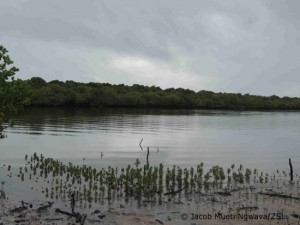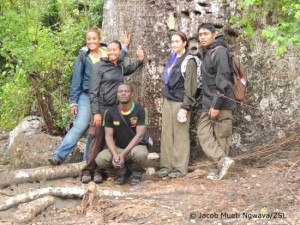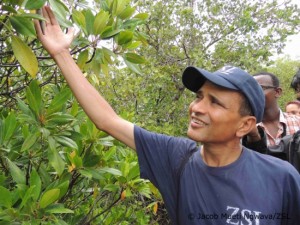As part of the EDGE Conservation Tools training course, the participants visit a wide range of community conservation initiatives. These trips give them a great insight into the conservation solutions being implemented in the local area. Jacob Mueti Ngwava, an employee of the National Museums of Kenya, gives an overview of one of the projects visited…
Involving local communities in conservation activities

Community involvement is pivotal to the success of most biodiversity conservation initiatives. It is key to garnering support and gaining conservation good will from the people who live with the species we are working to conserve. These people also hold a great wealth of indigenous knowledge regarding the species occurring in their neighborhood.

A good example of such an endeavour is the Gazi Women Mangrove Boardwalk in the Kenyan South Coast. This is a fantastic example of a local community women’s conservation group that has worked hard to reclaim the mangroves of Gazi Bay that had been cleared for building materials and fuel. Ten years ago, the land on the bay was devoid of any substantial mangrove cover. But then the women came together and initiated a mangrove planting project. Now, as one walks on the boardwalk, there is clear evidence of a dense mangrove forest.

As part of the EDGE Conservation Tools course, participants had the wonderful opportunity to visit the Gazi Bay Mangrove Boardwalk. One of the local women acted as our tour guide, giving explanation of the work that have been done to conserve the mangroves. Six species of mangroves exist in the Gazi Bay region: yellow mangrove (Ceriops tegal); orange mangrove (Brugiera gymnorrhiza); red mangrove (Rhizophorus mucronata), apple mangrove (Sonneratia alba), cannibal mangrove (Xylocarpus granatum) and the grey mangrove (Avicennia marina). Women guides regularly take visitors on tours along the boardwalk and the small fee they charge is pooled back into establishing more mangrove nurseries, repairing the boardwalk, paying the women tour guides, and helping with medical services in the community. These benefits boost the morale of the local community and improve their attitudes to mangrove conservation and biodiversity conservation more generally.
Long live the Gazi Women Mangrove Boardwalk!
The EDGE Conservation Tools training course forms part of the EDGE Fellowship programme – to learn more click HERE